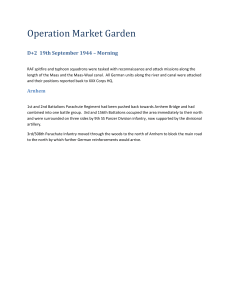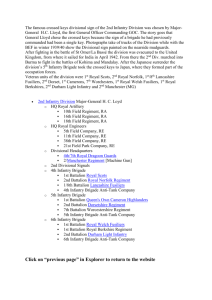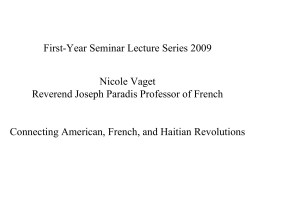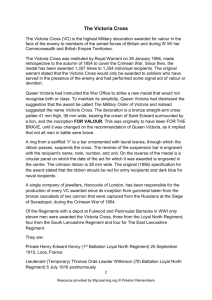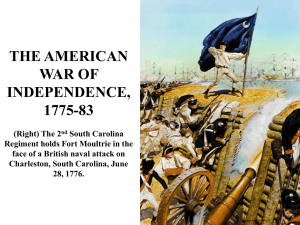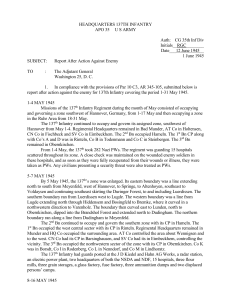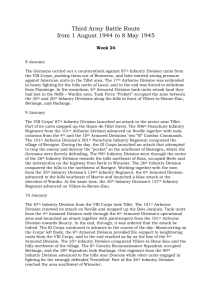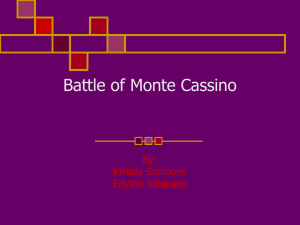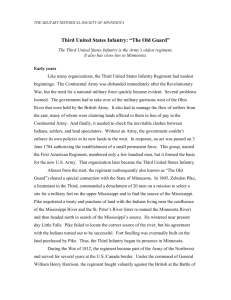The Rifles History
advertisement
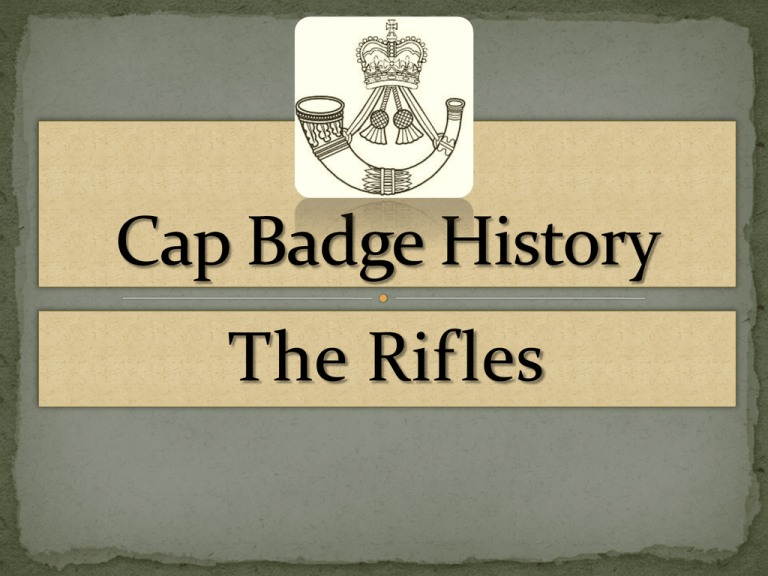
The Rifles The Rifles was created as a result of the Future Army Structure. Under the original announcement, the Light Division would have remained essentially unchanged, with the exception of the Light Infantry gaining a new battalion through the amalgamation of two other regiments, and both gaining a TA battalion. However, on 24 November 2005, the MOD announced that the four regiments would amalgamate into a single five-battalion regiment. The Rifles was formed on 1 February 2007 by the amalgamation of the four Light Infantry and Rifle Regiments of the Light Division The Devonshire and Dorset Light Infantry The Light Infantry The Royal Gloucestershire, Berkshire and Wiltshire Light Infantry The Royal Green Jackets The two existing battalions each of the Light Infantry and the Royal Green Jackets were renamed, while the single battalions of the DDLI and the RGBWLI were merged into one battalion. This brought the whole of the Light Division under a single cap badge. A Proud History As a rifle regiment, a private soldier in The Rifles is known as a Rifleman and Serjeant is spelt in the archaic fashion; the regiment wears a Rifle Green beret. A number of golden threads have been brought into the new regiment from each of its founder regiments: Croix de Guerre- the French Croix de Guerre ribbon awarded to the Devonshire Regimen in World War I, and subsequently worn by the Devonshire and Dorset Light Infantry, it is worn on both sleeves of No. 1 and No. 2 dress . Back Badge - the badge worn on the back of headdress reads Egypt. This was awarded as an honour to the 28th Foot, and subsequently worn by the Royal Gloucestershire, Berkshire and Wiltshire Light Infantry is worn on the forage cap and side hat, and on the Shako of the regimental band and bugles Bugle Horn - the bugle horn badge of the Light Infantry, now surmounted by St Edwards Crown, is the regiment's cap badge. . Maltese Cross - the Maltase Cross of the Royal Green Jackets is worn as a buckle on the cross belt, and will contain the regiment's representative battle honours; currently one space is kept free for future honours. In accordance with the tradition of rifle regiments, the regiment does not carry colours Black Buttons - the traditional black buttons of a rifle regiment are worn on all forms of dress with the exception of combat dress. In addition, the new regiment's "Double Past" march (the music used when marching past at the double) is an amalgam of the Light Infantry's (Keel Row) and the Royal Green Jackets' (Road to the Isles). In 1800, an "Experimental Corps of Riflemen", was raised by Colonel Coote Manningham and LieutenantColonel the Hon. William Stewart, drawn from officers and other ranks from drafts of a variety of British regiments. these were known as The chosen men The Corps differed in several regards from the Line infantry of the British Army. Most significantly, the Rifles were armed with the formidable Baker rifle, which was more accurate and of longer range than the musket, although it took longer to load. As the rifle was shorter than the musket, it was issued with a 21inch sword bayonet. The Baker rifle could not usually be reloaded as fast as a musket, as the slightly undersized lead balls had to be wrapped in patches of greased leather 3 aimed Shots a minute Accuracy was of more importance than rate of fire when skirmishing. The rifleman's main battlefield role was to utilise cover and skirmish Riflemen wore dark green jackets rather than the bright red coats of the British line infantry regiments of that time; close-fitting pantaloons, rather than breeches; black facings and black belts rather than white; a green plume on their "stovepipe shakoes" which the light infantry also wore, as well as other accoutrements unique to Rifles regiments. The riflemen were trained to work in open order and to be able to think for themselves. They were to operate in pairs ahead of the main infantry, which were bunched in close formations. They were taught to make best use of natural cover and to harass the enemy with aimed shots . These tactics, which had originated in campaigns in North America, were unorthodox for the time. It was considered too impractical for individual soldiers to aim at specific targets and conventional tactics favoured the mass volley from a close formation and the bayonet The treatment of soldiers in the new Rifle Corps was markedly different from the line infantry. Although flogging existed as a means of enforcing military discipline, it was seldom used. The unit held regular shooting and sporting competitions, and men were rewarded for their achievements. Officers would regularly dine with their men and so became familiar with each man in their respective companies, an unusual practice at the time. The 95th Regiment In 1802 the Rifle Corps was brought into the line of the British Army as the 95th Regiment of Foot, the 95th Rifles. In 1803 the 95th moved to Shornclife, Kent, where it underwent training, along with the light infantry regiment the 43rd and 52nd Regiments of Foot, under the tutelage of Colonel Coote-Manningham and Sir John Moore, the latter, like the 95th, would gain fame during the Peninsular War. 2nd Battalion In 1805 a 2nd Battalion was raised at Canterbury, Kent The 95th fought in numerous major battles and skirmishes during the campaign as part of the elite Light Division The 95th, having seen distinguished service in the Napoleonic Wars, became the "Rifle Brigade“ the 95th was reassigned in 1823 to the newly formed county regiment of the 95th (Derbyshire) Regiment of Foot Battle honours The following battle honours are a representation of the total honours awarded to the regiments which formed The Rifles. These are inscribed on the regiment's belt badge: Gibraltar, Copenhagen, Plassey, Dettingen, Minden, Quebec, Martinique, Marabout, Peninsula, Waterloo, Afghanistan, Jellalabad, Ferozeshah, Delhi, Lucknow, New Zealand, Pekin, South Africa, Inkerman Great War: Nonne Boschen, Ypres, Somme, Vittorio Veneto, Megiddo Second World War: Calais, El Alamein, Kohima, Pegasus Bridge, Normandy, Italy 1943-45, Anzio Imjin, Korea, Iraq 2003
